This was published 6 years ago
Russia travel guide and things to do: The highlights of the FIFA World Cup 2018 host nation
By Ute Junker
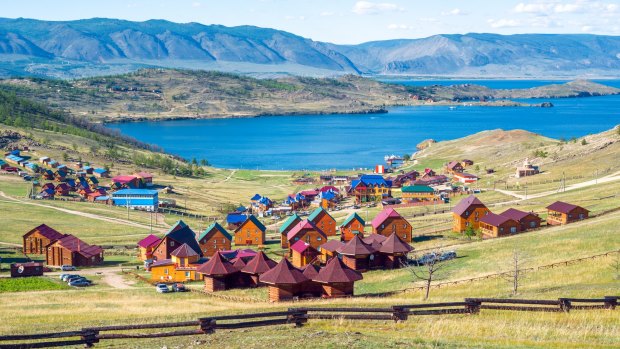
Lake Baikal: The deepest lake in the world.Credit: Shutterstock
Russia, in 100 days time or so, will have a rare opportunity to present itself to the world as an alluring travel destination where, beyond the stereotypical endless queues, bowls of borscht and athletic mischiefs, you may find yourself wandering into a millennial-old place of worship, be awed by a grandiose imperial palace or stroll along city streets towered over by golden minarets.
Given the sheer scale of the country, Russia is also the perfect place to undertake an epic journey, whether you ride the rails or cruise one of its mighty rivers. And then there is its diversity of cities from Moscow and St Petersburg to lesser-known centres such as Nizhny Novgorod and Saransk.
But, as Russia races to finalise preparations for its hosting of the FIFA World Cup in three months time – the 21st edition of what is probably now the world's biggest sporting event – those cities, all of which will host matches, are just the start of Russia's manifold attractions which include soaring mountains and forest-filled taiga.
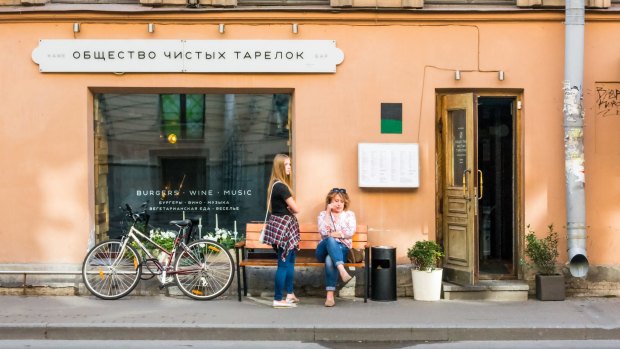
The bar Society of Clean Plates in St Petersburg.Credit: Shutterstock
When the first ball of the FIFA World Cup is kicked off on June 14, with Australia's Socceroos having qualified for the tournament, the global spotlight will shift from the recent highly politicised Winter Olympics in Korea and fall on Russia.
Even if you're not attending the World Cup, Russia's hosting of the event is an opportunity to consider a visit to this controversial though captivating land. But do be warned: narrowing down your options can be a challenge, as our special Traveller guide shows.
THE NATURAL WONDER: LAKE BAIKAL
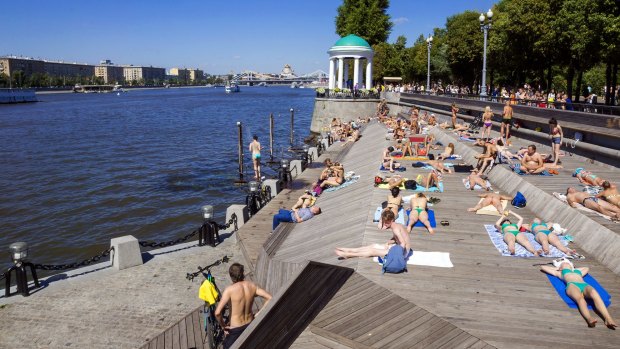
Olive Beach in Gorky Park.Credit: Shutterstock
WHERE IS IT In southern Siberia, Lake Baikal is not just the deepest lake in the world – plunging to depths of 700 metres – but is estimated to hold 20 per cent of the unfrozen fresh water on the surface of the planet.
WHY GO Covering an area of almost 32,000 square kilometres, Lake Baikal is its own eco-system, with two-thirds of its flora and fauna found nowhere else in the world. It has 27 islands, shoreline walking tracks, pretty villages and hot springs. Surprisingly, it is also the centre of Buddhism in Russia, home to the Ivolginsky Datsan monastic centre.
DON'T MISS Baikal's largest island, the 72-kilometre-long Olkhon, is a place of grassy meadows, sandy beaches and dramatic cliffs. Hire a kayak to explore its coastline, or climb into a Soviet army jeep to visit key sights such as the Shaman Rock, a sacred place for Siberia's indigenous Buryat people, and Cape Khoboy, the very northern tip of the island, where seals can sometimes be seen basking on the rocks.
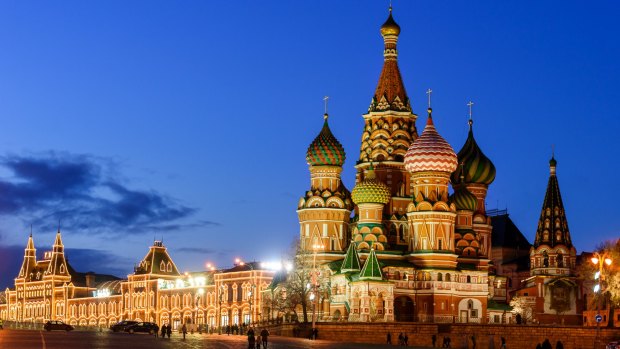
St. Basil's Cathedral in Moscow.Credit: Shutterstock
With pretty wooden houses surrounded by immaculate gardens, the village of Listyanka on the lake's southwestern shore is one of Baikal's most popular destinations. As well as sunning yourself on the pebbly beach (be aware that the lake's water is cold even in midsummer), you can sample smoked omul fish, a local delicacy, at the waterfront market, or follow the Great Baikal Trail through the pine forest to the village of Bolshiye Koty.
STAYING THERE There are a number of guesthouses in the area, including Nikita's Guesthouse on Olkhon (olkhon.info/en), but many visitors sign up for a homestay experience. Many of the homestays have their own sauna, making this a great opportunity to try this ancient tradition.
ESSENTIALS Summer is peak season at Lake Baikal; come during May and early June to beat the crowds and still enjoy mild weather. Irkutsk is the most convenient airport for both Listvyanka and Olkhon. Alternatively, Steppes Travel's seven-day Lake Baikal Adventure includes stops at Listvyanka and Ulan Ude, the centre of Buddhism in Russia. From £1620pp. See steppestravel.com
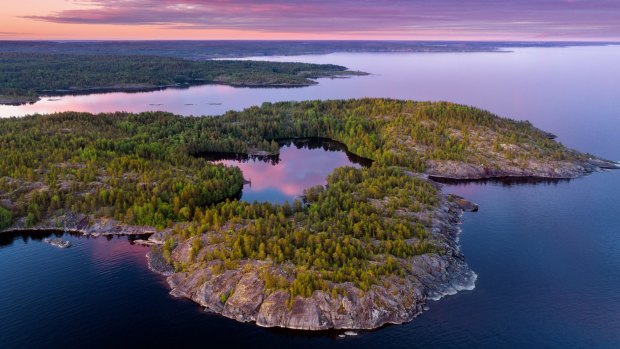
Karelia: One of Russia's loveliest wildernesses.Credit: Shutterstock.com
THE COUNTRY RETREAT: KARELIA
WHERE IS IT Four hundred kilometres north of St Petersburg, bordered on one side by Finland and on the other by the Arctic Circle, lies Karelia, one of Russia's loveliest wildernesses. Its 700 kilometres are covered with dense forests studded with no fewer than 60,000 lakes.
WHY GO Karelia is a magical destination no matter which season you choose. Head here in summer and you will be able to enjoy the famous White Nights, when the midnight sun sits high in the sky and the forests are full of wild blueberries and cloudberries. Come in winter and you can enjoy the thrill of dog sledding and snowmobiling.
DON'T MISS During summer, the Solovki archipelago near the Arctic Circle is a popular destination, particularly the World Heritage-listed Solovestky Monastery. Now one of the richest monasteries in all of Russia, the 500-year-old monastery filled a very different function during Soviet times, when it was part of the infamous Gulag prison system. In winter, take a snowmobile trip across the frozen Lake Onega to Kizhi Island, home to the magnificent Cathedral of the Transfiguration, crowned with 22 onion domes. This is also a wonderful place to see the shimmering glow of the northern lights, and perhaps try your hand at ice-fishing.
STAYING THERE There is a range of accommodation available across Karelia, including guesthouses and Scandinavian-style chalets. One of the best modern hotels is Frigate on the shores of Lake Onego. From RUB3600 twin share including breakfast. See frigatehotel.com
ESSENTIALS Artel Troika offers multi-day summer and winter tours from €720. See arteltroika.com
THE LONGEST RIVER: THE VOLGA
WHERE IS IT Europe's longest river flows through Central Russia all the way to the Caspian Sea, but most cruise companies concentrate on the stretch between Moscow and St Petersburg. Known as the Golden Ring, this is home to a string of medieval towns that includes some of Russia's most-loved tourist destinations.
WHY GO This is the Russia that launched a million postcards: wooden houses, riotously coloured churches and monasteries, flower-studded meadows and endless onion domes shining in the sunlight.
DON'T MISS Each of the stops on the Golden Ring has its own charms, but Yaroslavl is a special place. The biggest and oldest town of the towns, this 1000-year-old city has a lovely neoclassical city centre, while the Volga Embankment is a perfect spot for strolling. Other popular stops along the route include Kostroma, the hometown of the Romanov dynasty, and Rostov-Veliky. If you prefer a more adventurous itinerary, head further downstream to Kazan, where east meets west. The capital of the republic of Tatarstan, Kazan is a city of minarets as well as onion domes, a place where the street signs are in Tatar as well as Russian. The city's magnificent Kremlin is its most famous attraction, but other architectural standouts include the over-the-top Ministry of Agriculture building.
ESSENTIALS Scenic's all-inclusive 15-day Imperial Russia cruise travels through the Golden Ring from Stalingrad to Moscow, offering a range of shore excursions along the way. From $8795. See scenic.com.au
THE CLASSIC JOURNEY: TRANS-SIBERIAN RAILWAY
WHERE IS IT Known as one of the world's greatest train journeys, there are three separate routes that collectively comprise the Trans-Siberian Railway. The longest, from Moscow to Vladivostok, covers an astonishing 9258 kilometres and takes seven days non-stop – longer, if you choose to alight along the way.
WHY GO Railways fans will tell you there is no better way to see a country than riding the rails, and the Trans-Siberian Railway offers some astonishing panoramas, from the endless forests of larch, birch, silver fir and pine trees to the 180-kilometre section that skirts the edge of Lake Baikal. For some travellers, it is the slightly surreal experience of the train trip itself – complete with stops in the middle of the night and long afternoons spent in the dining car – that is the main attraction.
DON'T MISS You could stay on the train and do the journey all in one hit, but why would you? A number of tour operators offer itineraries that include stops along the way. Popular places to explore include the Siberian town of Irkutsk, with its lovely 19th-century buildings, and Lake Baikal.
ESSENTIALS Accommodation options on the standard trains include first class, second class and (a very basic) third class. Each train has western-style toilets, wash rooms and a dining car. World Expeditions offers a 19-day Classic Trans Siberian itinerary, travelling across Russia, China and Mongolia. From $5790. See worldexpeditions.com The Golden Eagle Luxury Train offers well-appointed cabins with double beds (compared with the bunks on the standard train), en suites and welcoming lounge and dining cars. Meals with wine are included in the price, as are excursions at various stops. From $US11,895 for a 15-day tour. See goldeneagleluxurytrains.com
THE ULTIMATE ADVENTURE: THE RING OF FIRE
WHERE IS IT Right at the edge of Russia's eastern boundary is the Kamchatka Peninsula, a 1250-kilometre-long tongue of land stretching into the Pacific Ocean. Part of the geologically active zone known as the Ring of Fire, the wonderfully wild Kamchatka is Russia's equivalent of Alaska.
WHY GO How is it that so few people know about Kamchatka's stunning beauty? Think snow-capped volcanoes, white-water rivers filled with salmon and steaming hot springs. Part of it is down to its remoteness, but part of it is also down to history. This was where the Soviet Union stationed its Pacific Fleet, making this area off limits to just about everyone. It is only recently that expedition cruises have started exploring its magnificent landscapes.
DON'T MISS Get set to enjoy some magnificent wildlife sightings: anything from arctic fox to sea otters to brown bears. Archipelagos such as the Commander Islands are home to huge colonies of seabirds, including sea eagles, puffins and auks. The waters teem with whales, fur seals and porpoises. The deserted beaches of Cape Navarin are the places to keep an eye out for basking walrus, while the nearby Keyngypilgyn Lagoon is known for its rich population of geese, swans and eiders.
ESSENTIALS Expedition cruises take place during the northern summer. Wildwings offers a 12-day Kamchatka: Ring of Fire Cruise aboard the Spirit of Enderby, departing from Sakhalin. From £5865 for a twin basic cabin. See wildwings.co.uk
THE IMPERIAL CAPITAL: ST PETERSBURG
WHERE IS IT St Petersburg sits on the Gulf of Finland, flanked by Finland and Estonia.
WHY WE LOVE IT Conjured up out of marshland by Peter the Great, St Petersburg is not just Russia's most romantic city, thanks to its canals, palaces and elegant townhouses, but also its most history-filled destination.
DON'T MISS You could spend several days just visiting the Hermitage Museum, where the artistic masterpieces compete for attention with the building itself, a former imperial palace. More imperial palaces lie just outside the city – the opulent Peterhof and Tsarskoe Selo are must-visits – but there is much to see in town itself, including Vasilevskiy Island. St Petersburg's churches are magnificent – the dazzling Church of the Saviour on Spilled Blood outshines even St Isaac's Cathedral – but one of the great joys of this city is going for a walk and seeing what you discover. From the promenades on Nevsky Prospekt to quiet side streets lined with beautiful belle epoque architecture, the city is made for strolling.
STAYING THERE For imperial grandeur, the magnificent Belmond Grand Hotel Europe is hard to beat. Off Nevsky Prospekt, a short walk from the Hermitage, this grande dame has all the bells and whistles, including a Caviar Room. From RUB17,500 twin share for bed and breakfast. See belmond.com
The family-run Alexander House Hotel offers 20 rooms, each named after a different global destination. With a 24-hour restaurant, welcoming common areas and helpful staff, this hotel ticks all the boxes. From RUB5940 per room twin share including breakfast. See a-house.ru
ESSENTIALS For many, the best time to visit is during the White Nights, the period between May and July when the city enjoys almost around-the-clock daylight. Although there are good flight connections with destinations right across Europe, St Petersburg also has excellent ferry and train connections with various Scandinavian cities. Evergreen's all-inclusive 12-day Imperial charms of Russia cruise includes four days exploring St Petersburg and its Hermitage Museum and shore excursions along the way to Moscow. From $5250. See evergreentours.com.au
THE COSMOPOLITAN CAPITAL: MOSCOW
WHERE IS IT Moscow lies about 700 kilometres south-east of St Petersburg.
WHY WE LOVE IT Big, bold and bustling, Moscow is a city filled with confidence – and rightly so. There is the spectacular Red Square, the lively Old Arbat and the ever-impressive Metro, where the stations double as works of art.
DON'T MISS Sooner or later, every visitor ends up at Red Square. The question is, what to check out first? There is Lenin's tomb, the candy-cane domes of St Basil's Cathedral, and even the city's elegant shopping mall, GUM, where the architecture is as gorgeous as the window displays. Right next door sits the mighty Kremlin, the city's ancient power centre. There is plenty to see in this complex of palaces and cathedrals. Don't miss The Armoury, which displays priceless treasures including royal costumes, sumptuous imperial carriages and priceless Faberge eggs, including the Grand Siberian Railway egg, with gold train, platinum locomotive and ruby headlamp. Art lovers should head for the Moscow Museum of Modern Art, displaying works by Kandinsky, Chagall and Malevicj among others.
STAYING THERE For more than a century, the Metropol has been the place to stay in Moscow. Just a few steps from Red Square, this sumptuous hotel has hosted everyone from Lenin and Stalin to Michael Jackson. From RUB15,000 a night twin share. See metropol-moscow.ru
Prefer something a little more contemporary? The StandArt Hotel has a vaguely '50s feel teamed with graffiti murals. The inhouse restaurant Sever-Yug is helmed by Michelin-starred chef Angel Pascual. From RUB12,000. See standarthotel.com/en/
ESSENTIALS Moscow is known for its extreme climate, with hot summers and freezing winters. The most pleasant temperatures occur between April and June. There are good flight connections with many European cities.
RUSSIA: DOS AND DON'TS FOR A SUCCESSFUL TRIP
DO Swot up on the Cyrillic alphabet; you will need it to decipher street signs and Metro stations, among other things. One useful hint: the word "PECTOPAH" is actually "RESTAURANT".
DON'T leave your planning to the last minute. The Russian visa process can take several weeks, so allow plenty of time. Remember to get your visa registered when you arrive, too.
DO think about your wardrobe. If you are stepping inside a church, women should cover their hair and shoulders, and sometimes skirts – not pants – are required. Men should wear long trousers and remove their hats.
DON'T leave your passport at the hotel; carry it with you always. You may be asked by police to present it, and a photocopy won't cut it.
DO leave your shoes at the door if you are invited into someone's home. Wearing shoes inside is considered rude – and dirty.
RUSSIA AND ITS STEREOTYPES: TRUE OR FALSE?
RUSSIANS NEVER SMILE
FALSE However, it is fair to say that Russians don't waste time smiling at strangers, just as they don't make small talk. That can make them seem unfriendly at first, but it is something that you get used to.
THEY ALL DRINK STRAIGHT VODKA
FALSE (ISH) Russians drink a broad range of beverages, including tea, which is an essential accompaniment to virtually any social interaction. However, when they do drink vodka, they drink it straight. Don't try to keep up.
THEY SMOKE LIKE CHIMNEYS
FALSE Like many other countries, Russia outlawed smoking in public places several years ago. However, you will still find plenty of smokers congregating at entrances to bars and stations.
RUSSIAN TRAFFIC IS TERRIBLE
TRUE Well, it can be, particularly in the big cities. Traffic jams are a problem, as is the quality of the driving. There is a reason that so much Russian dashcam footage gets posted on YouTube: some of this stuff has to be seen to be believed.
RUSSIA IS A POOR COUNTRY
FALSE Call it a rich country with plenty of poor people. Russia falls just outside the top 10 of countries with the biggest GDP, yet many Russians find it difficult to make ends meet. Serious income inequality means that millions of Russians exist below the poverty line.
FIVE MORE GREAT RUSSIAN HOLIDAY HOTSPOTS
THE OUTLIER: KALININGRAD
Sandwiched between Poland and Lithuania, Kaliningrad has only been part of Russia since the end of World War II. Before then it was called Konigsberg and was the capital of Prussia. The city was largely destroyed during the war, but historic buildings including its mighty cathedral and the Brandenburg Gate have been rebuilt.
THE SKI RESORT: ROSA KHUTOR
Consistently topping the list of Russia's best ski resorts, Rosa Khutor in Sochi has 38 kilometres of ski runs ranging from beginners to black, with lifts taking skiers higher than 2200 metres. The ski season here can last for six months (the best skiing is usually in February and March) and ski passes are among the cheapest in Russia.
THE FAR EAST: VLADIVOSTOK
It has always enjoyed a scenic setting, embraced by gentle hills and sandy bays, but now Vladivostok, the de facto capital of Russia's Far East, is having a moment. Following the recent opening of the Primorsky Stage arts complex, overseen by St Petersburg's prestigious Mariinsky Theatre, the Hermitage Museum is also opening a local branch.
THE ANCIENT CAPITAL: VELIKY NOVGOROD
Don't get confused: Veliky Novgorod is a different place
to Nizhny Novgorod, the city formerly known as Gorky. Veliky Novgorod is one of Russia's most venerable cities and is packed with more than 20 World Heritage listed monuments, including Russia's oldest church, Sofia Cathedral.
THE WILDERNESS: THE ALTAI MOUNTAINS
This range of mountains stretching across southern Siberia has some spectacular scenery, from pristine glacier lakes to verdant meadows, dramatic gorges and snow-topped peaks. Trekking, rafting and spelunking are all popular activities, as are encounters with the nomadic tribes that still traverse the country as they have done for centuries.
Sign up for the Traveller Deals newsletter
Get exclusive travel deals delivered straight to your inbox. Sign up now.